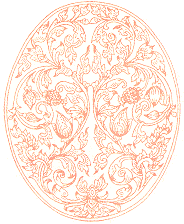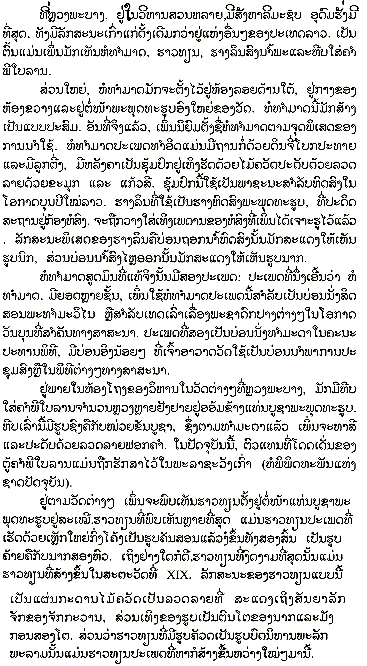In Luang Prabang, temple
furniture style and ornamentation are much richer and more original than elsewhere in
Laos. Pulpits, candleholders, hang un (holy-water conduits) and manuscript coffers for
example, can be identified.
The pulpits, always placed at the southern nave in the middle of the bay before
the main Buddha statue, are of mixed construction. In fact, the word ‘pulpit94 is
used to describe shelters or shrines that are designed for other uses as well.
The first kind, of carved wood, rests on a plastered and molded masonry base
with a horizontal surface. It is decorated with patterns in stucco and enameled lead and
is used as a shrine for sprinkling water on the Buddha images during the Laotian New Year.
The hang lin (water conduit) is placed above the roof of the shrine, which is pierced with
holes to sprinkle the Buddha statues placed below. The hang lin, whose main feature is its
bird-like shape and naga-shaped spout, was also used to sprinkle water on the King and
Queen during the Pimay festivities (Laotian New Year) and on new monks for their
ordination.
There are two types of genuine pulpits. The first, called ho thammad, features a
multi-tiered roof and is used for the teaching of Buddhist precepts or for the recital of
the episodes from Buddha's Jakarta during important religious festivals. The second type
is a low-backed simple seat where the head monk of the vat sits to preside over religious
gatherings.
In pagoda viharn halls in Luang Prabang, many manuscript coffers are placed by
the side of Buddha's altar. They are in the form either of a Laotian goblet or a cupboard
and are usually painted and decorated with golden stencils. The most typical are those
currently preserved in the former royal palace, the National Museum of Luang Prabang.
Placed on Buddha's altar, the candleholder can be found in all temples. The most
common are those shaped as a curved iron stem turned up at the ends, resembling a
two-headed naga. But the most beautiful are those made in the 19th century in
the form of a carved wooden screen charged with cosmic symbolism; with the upper part of
the screen representing the body of two magara-naga. Carved candleholders decorated with
scenes representing the Laotian Ramayana are from a more recent date.

